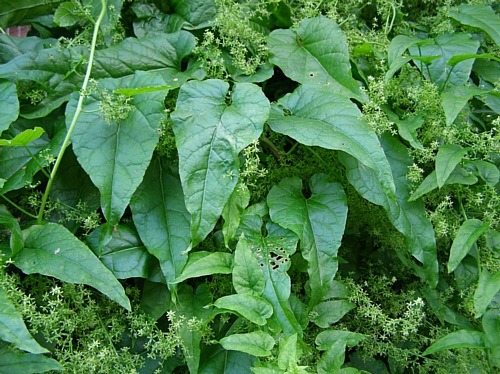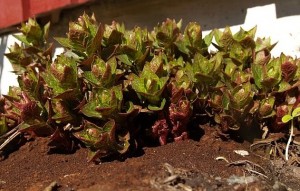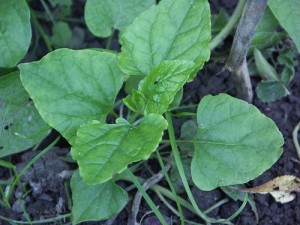I like to think of myself as biclimatic, living 42% of my life (thus far) in a cold climate and 58% in a warm climate. There are virtually thousands of wild edibles and I’ll never be able to write about all of them. Most of the foraging books strike a temperate balance which is why I add a higher percentage of warm species to my pages. They just aren’t covered. This plant, however, is for all my relatives who are still in love with snow, ice, frozen pipes and frostbite.
The Spinach Vine is a native of the Caucasus Mountains where it thrives in dappled forest sunlight. The growing season is short, the winters polar bear cold at higher elevations. It is there that this wild edible vine takes advantage of every no-frost day to put on a fine display of edible leaves. Closely related to Chenopodiums — Lamb’s Quarters, Fat Hen — it’s edible raw or cooked. That makes it a hot item in vegetable gardens and permaculture plans particularly in cooler climates.
Not surprisingly this wild edible is a cultivated sensation in Scandinavia which is known for having a chilly night or two (the coldest I ever experienced was 53 below zero. We went ice skating just to say we did. The bonfire and hot coffee did not keep us warm. Twenty feet from the fire you would freeze to death. Personally, I would live on the Equator if I could.) In the northern growing season the Spinach Vine will manage nine to twelve feet of bushy growth. Interestingly, like our local milkweed vine (Morrenia odorata) the lower leaves are heart-shaped on long stems, older leaves more arrow shaped, flowers small and green. Seeds are black and shiny.
 Botanically the plant is monotypic, which means it is the only plant in its genus (read it has the botanists confused.) As for the name, Hablitzia tamnoides… (hab-LITZ-ee-uh tam-NOY-these.) If you remember from my Botany Builder lessons in my weekly articles, “oides” OY-deez means resembles or looks like. In this case tamnoides means looks like the edible Tamus communis, or the Black Bryony (which oddly is in the yam family.) Hablitzia honors Carl Ludwig Hablizl, aka Karl Ivanovich Gablitz, a naturalist in the late 1700s and early 1800s who also happened to be a vice-governor in Crimea. That’s supposed to be handsome Carl on the upper left according to a Russian website but I doubt it. His dates are 1752 to 1821. He’d have to be 69 in the photo and photographing people didn’t happen until the late 1830s. Perhaps a son. Carl was born in Prussia but moved with his father at age six to Russia in 1758. From 1769 to 1773 he participated in a scientific expedition to southern Russia, exploring the lower Volga (as if no one had before him.) Carl became the caretaker of the treasury garden in Astrakhan in 1781 then took part in a Caspian expedition for Count Voinovich in 1783 looking for plants, animals and artritocratical birthplaces among lowly Greeks (a long story best left to baptismal intrigue.)
Botanically the plant is monotypic, which means it is the only plant in its genus (read it has the botanists confused.) As for the name, Hablitzia tamnoides… (hab-LITZ-ee-uh tam-NOY-these.) If you remember from my Botany Builder lessons in my weekly articles, “oides” OY-deez means resembles or looks like. In this case tamnoides means looks like the edible Tamus communis, or the Black Bryony (which oddly is in the yam family.) Hablitzia honors Carl Ludwig Hablizl, aka Karl Ivanovich Gablitz, a naturalist in the late 1700s and early 1800s who also happened to be a vice-governor in Crimea. That’s supposed to be handsome Carl on the upper left according to a Russian website but I doubt it. His dates are 1752 to 1821. He’d have to be 69 in the photo and photographing people didn’t happen until the late 1830s. Perhaps a son. Carl was born in Prussia but moved with his father at age six to Russia in 1758. From 1769 to 1773 he participated in a scientific expedition to southern Russia, exploring the lower Volga (as if no one had before him.) Carl became the caretaker of the treasury garden in Astrakhan in 1781 then took part in a Caspian expedition for Count Voinovich in 1783 looking for plants, animals and artritocratical birthplaces among lowly Greeks (a long story best left to baptismal intrigue.)  Called an academic Carl wrote The Natural history of East Tartary, 1789, a book of some 216 pages available on line for about $12, used. Not sure how his name of Gablitz, same as a town in Austria — Vienna Woods in fact — got transliterated into Hablizl. Here’s a guess, though: When you’re Germanic and but working for a Russian count perhaps it was prudent to change the spelling of your name. Would Gablitzia tamnoides be much different than Hablitzia tamnoides?
Called an academic Carl wrote The Natural history of East Tartary, 1789, a book of some 216 pages available on line for about $12, used. Not sure how his name of Gablitz, same as a town in Austria — Vienna Woods in fact — got transliterated into Hablizl. Here’s a guess, though: When you’re Germanic and but working for a Russian count perhaps it was prudent to change the spelling of your name. Would Gablitzia tamnoides be much different than Hablitzia tamnoides?
Green Deane’s “Itemized” Plant Profile: Spinach Vine
IDENTIFICATION: Perennial, small its first year, needs a trellis, vine to about 12 feet, many branches, green five-petaled flowers, shoots green and red, ruddy, wrinkled heart-shaped leaves when young, more arrow shaped when older. Seeds, kidney shaped, flattish, biconvex, edge rounded, smooth, glossy black.
TIME OF YEAR: Summer, start in a hotbox, it can take some frost in the fall. If you are going to grow it in a warm climate the seeds need to be kept in the frig for a while, chill hours improve germination.
ENVIRONMENT: In its native range it likes Spruce and Beechwood forests, gullies and ravines.
METHOD OF PREPARATION: Leaves and shoots, raw or cooked. Tastes similar to musky nettles.
And for the heck of it, the name in several languages:
BULGARIAN : Кавказий шпинат Kavkazii shpinat.
CHINESE : 高加索菠菜 Gao jia suo bo cai.
DANISH : Spinatranke.
DUTCH : Kaukasus spinazie.
ENGLISH : Spinach Vine, Caucasian spinach, Caucasus spinach, Climbing spinach, Hablitzia.
FINNISH : Köynnöspinaatti.
FRENCH : Épinard grimpant du caucase.
GERMAN : Kaukasische Spinat.
GREEK : Καύκασος σπανάκι Kuvkasos spanaki.
ITALIAN : Spinacio del Caucaso, Spinaci di Caucasi.
JAPANESE : コーカサスのホウレンソウ Kookasasu no horensou, コーカサスのほうれんそう Kookasasu no horensou, コーカサスの菠薐草 Kookasasu no horensou.
POLISH : Szpinak kaukazki.
PORTUGUESE : Espinafre de Cáucaso.
RUSSIAN : Габлиция тамусовидная Gablitsiia tamusobidnaia.
SPANISH : Espinaca del Cáucasia, Espinaca del Cáucaso.
SWEDISH : Rankspenat.
TURKISH : Ispanak Kafkasya.





Wonderful info – and the images are very helpful… I have only ever seen spinach vine illustrated on a seed packet, and have wondered…
Hello Deane, I purchaced a plant from a seed catalog some years ago with no latin name . But it was called eatable perenial spinich vine. It doesn’t look like the picture above.It has rounds fleshy leaves, and the entire plant is maroon tinged. The stems are maroon and the berries which are growing off of a long stem are green at first than turning dark purple. The hole plant tasts like purslane. Also, it has to stay in the warm. Is this just a variation or did they give me something else?
Sounds like Malabar Spinach.
Thank you, it is very delicious!
‘Kaukasus spinazie’ in dutch? I don’t know what exactly the official name would be in Dutch but it would at least be ‘Kaukazische spinazie’ (‘Caucausian spinach’), we wouldn’t say ‘Caucasus spinach’, and I think rankspinazie is the most commonly used name… Not that much people ever talk about it,
But good article overall. More people should know about this plant…
where I buy the seeds of the plants you show on you web site
I don’t sell seeds. But Andy Firk, on facebook, does.
Love your site! Though I’d like to recommend spell checking before publishing. For example: “…kept in the frig “.
I consider misspellings copyright traps. That said I would also add that refrigerator is not spelled with a D. Seems to me shortening refrigerator to frig would be more accurate than spelling it fridge. And frigid — as in really cold — does not have a “d” before the G. Be damned the spelling police. I’m sticking with frig.
So is this spinach or just another use of the name? Does it taste like spinach? is it prepared like spinach? thanks in advance for your response…
I love my spinach vine. It really does taste like a dusky spinach!
Just got it from a new friend this summer. They shoot out leaves and you just eat them raw! I put mine in a hanging planter so it will be inside this winter.
Hi. Does this spin icy vine have any medicinal
Properties. Would love to know.
Many thanks Walre
I grew this plant from seed last Summer. They came up and were growing, though slowly, but they all slowly succumbed to some kind of blight. The plants slowly weakened then just separated at ground level. Anyone had luck growing them from seed?
Thanks, Ian Maas
I was able to start 5 plants inside a couple of years ago and am growing 2 of them in a mostly shady spot spot here in Salt Lake City. I put shade cloth in front of them last summer and they did fine with the heat and little sun exposure. Regular watering helps. We have a drip system. It’s Jan 30 and both plants are leafing out at the base. Of course, our winter has not been very winter like, AGAIN. 🙁